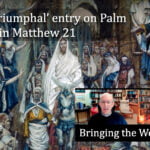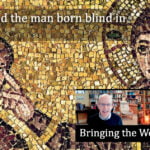 It is always a relief when we celebrate Palm Sunday from Matthew (as we do in this Year A in the lectionary) or Mark’s account (next year). Luke 19.36 in his account talks only about the garments, and does not mention palm branches, so in those years we have to call it Garment Sunday (which doesn’t have the same ring about it). In fact it is only John, the supposed ‘spiritual’ gospel, who specifies the palms. But if you are reading or preaching from Matthew’s account, what stands out?
It is always a relief when we celebrate Palm Sunday from Matthew (as we do in this Year A in the lectionary) or Mark’s account (next year). Luke 19.36 in his account talks only about the garments, and does not mention palm branches, so in those years we have to call it Garment Sunday (which doesn’t have the same ring about it). In fact it is only John, the supposed ‘spiritual’ gospel, who specifies the palms. But if you are reading or preaching from Matthew’s account, what stands out?
Matthew’s account of the events leading to the entry into Jerusalem is slightly briefer than Mark’s or Luke’s; the inclusion of the fulfilment of prophecy in Matt 21.4–5 replaces the narrative detail about the collection of the donkey(s). Matthew, and to a lesser extent Luke, omit some of the ‘eye-witness’ details found in Mark’s account—the exact question the disciples will be asked (Mark 11.3), the asking of it (Mark 11.5), the fact that the branches were ‘leafy’ (Mark 11.8; Mark uses the word stibas suggesting leafy palms, rather than Matthew’s more general klados). Matthew’s account is more ‘stream-lined’ in order to make the points that he thinks are significant.
Like Mark, but in contrast to Luke and John, Matthew includes the mention of the Mount of Olives as the location of the journey into the city. This might help remind his (largely Jewish?) readers of the story of David’s exile and return in 2 Sam 19–20, which will be referenced indirectly in the citation of Zech 9. It also has messianic connotations as expressed in Zech 14.4, and it becomes the location for the extended ‘eschatological discourse’ in Matt 24–25. From this spot, overlooking the city, we get a glimpse on the horizon of the end of all things—the climax of Jesus’ ministry, and beyond that the anticipation of his final return.
In Jesus’ instruction to the disciples, the phrase he gives them ‘The Lord has need of it’ must refer to the Lord God; Matthew nowhere uses ho kurios to refer to Jesus, even in his narrative comments (a striking contrast to Luke’s usage). And, different from Mark’s account, the second phrase must mean, ‘he [i.e. the man you ask] will let you have it immediately’ rather than ‘he [the Lord] will return it immediately’. Jesus is clear that, in this action, he is fulfilling God’s own purposes.
A striking feature is the emphasis on the impact that Jesus has. The ‘large crowd’ that has followed Jesus from Jericho in Matt 20.29 has become a ‘huge crowd’ in Matt 21.8. (Some translations render this ‘many of the crowd’ but this is not the best translation of the unusual phrase. The word is pleistos, the superlative of polus, ‘many’. Matthew’s use here is perhaps the equivalent of the way we might say in English ‘there was the most enormous crowd’ where our use of ‘most’ doesn’t actually make literal sense since we are not actually comparing it with other crowds.) It is worth noting that, though many versions title this episode ‘The Triumphal Entry’ or some such, the acclaim happens before Jesus enters the city, not at his entrance. When he does finally come into Jerusalem, Matthew alone notes that ‘the whole city was stirred’ in verse 10. Here he highlights the divide between the Galileans, the pilgrim crowd, who acclaim Jesus, and the local Judeans who do not. I have always felt this was much more historically plausible as an explanation of what is happening.
Contrary to the hymn ‘My Song is Love Unknown‘ (Sometimes they strew His way/And His sweet praises sing…Then “Crucify!” is all their breath…) it is not the same crowd that praised him this week who call for his crucifixion the next, but different groups responding to Jesus differently. (The other gospels treat this issue in a variety of ways. Mark makes nothing much of it in this episode. Luke 19.39 describes Pharisees within the crowd as offering a dissenting voice, and in response to them Jesus talks of the fall of Jerusalem. The Fourth Gospel also mentions Pharisees in John 12.19, and goes on to talk about Greek from the north who want to meet with Jesus.) And the Galilean crowd emphasise that this king-like person is not local, but from Nazareth; whereas Judea was ruled directly by Rome through a prefect, Galilee was a separate region ruled by Herod as tetrarch. So the political threat would have been all the more obvious.
Up to this point, Jesus has walked everywhere with his disciples on foot—and it appears that the expectation was that Passover pilgrims should arrive at the city on foot. So Jesus’ riding on a donkey would have been very conspicuous amongst the crowds; he could have chosen to remain incognito by walking if he had chosen. The use of a donkey was not a sign of poverty as such; it was the most common animal at the time for a range of work roles. Its primary significance is found in the fulfilment of the conflated prophecies in Zech 9.9–10 with the opening phrase from Isaiah 62.11. The Zechariah text in turn alludes to David’s entry into the city after the defeat of Absalom in 2 Sam 19.
Matthew deploys his characteristic ‘fulfilment’ formula, ‘This was to fulfil…’ (compare Matt 1.22, 2.15, 2.17, 4.14 and so on), mentioning only the great prophets Isaiah and Jeremiah by name, with all others simply noted as ‘the prophet’. Fulfilment of Scripture is a repeated theme for Matthew, and here the citation takes the place of the explicit acclamation of Jesus as king in the other gospel accounts. The fact that he is ‘a prophet’ (Matt 21.9) has already been highlighted by Matthew’s placing him on a mountain in Matt 5.1 (rather than a ‘level place’ in Luke 6.17) and organising his teaching into five blocks.
Matthew does not follow exactly either the Greek or Hebrew versions of the text, but edits and adapts it to suit the point he is making. The context is emphatically one of peace that has come through victory:
I will take away the chariots from Ephraim and the warhorses from Jerusalem, and the battle bow will be broken. He will proclaim peace to the nations. His rule will extend from sea to sea and from the River to the ends of the earth. (Zech 9.1o)
Whilst this alludes to the historical episode of David, it also picks up the way that other parts of the OT elevate the Davidic kingship to point to a future, ideal figure who will bring God’s final liberation and rule to his people. The second half of Zech 9.10 echoes Ps 72.8, set to music by Isaac Watts in his hymn ‘Jesus shall reign where’er the sun‘. But Matthew omits one key part of the verse: ‘he comes in vindication/righteousness and peace’. David had already won his victory and came to offer peace; Jesus comes to offer peace, but in Jerusalem he will win the victory and be vindicated in his cross and resurrection. God promises in Zech 9.11:
As for you, because of the blood of my covenant with you, I will free your prisoners from the waterless pit.
Jesus comes to offer his blood of the new covenant to proclaim new life to all.
The true king arrives, not as conquering hero but proclaiming peace, not presuming to impose his will, but hoping to be welcomed willingly. In this sense Jesus is demonstrating by his own example the teaching he has been giving in Matt 20.25–28. Though he has forbidden proclamation of his identity in Matt 16.20, his actions speak louder than their words.
There is no particular need to think of the arrangements as miraculous; we know from John 11 and John 12 that he has contacts in this area. The mention of an ass and a colt here (compared with only one animal in the other accounts) looks like Matthew’s characteristic doubling—in many of Jesus’ miracles, he deals with two people in Matthew where Mark and Luke only mention one. There is no simple explanation for this—Davies and Allison mention nine possibilities in their commentary, none of which they believe satisfactory! It is worth noting that, in many cases, it is historically plausible; those in need tend to group together. And if the colt here has never been ridden before, it would be quite natural that its mother comes with it. Matthew would know how to read Hebrew parallelism in Zech 9, so it is rather odd to suggest he has misunderstood the passage. But, like others of his day, he shows an interest in the fulfilment of the passage in its form, not just its content, and mentioning both animals helps to emphasise this.
So Jesus is presented as fulfilling the purposes of God. Having silenced those who proclaimed him earlier, he now makes no secret of who he is. Although his claims had inevitable political implications, Matthew focuses on his role as the Son of David and the prophet who was to come. His arrival draws a huge following—but it also divides people in their loyalty. Jesus is not someone who encourages sitting on fences!
Additional note: The illustration at the head of this article is a section from a painting by James Tissot, a nineteenth-century French painter and illustrator who moved to London in 1871. He was close to the Impressionists, and was invited to be part of the first Impressionist exhibition in 1874, but he declined and (in contrast to other French painters), moved to a more realistic, rather than impressionistic, style of painting. After moving to London, in 1885 he experienced a renewal of his Roman Catholic faith, and devoted himself to painting scenes from the Bible, aided by travelling to the Middle East. He created a series of 365 painting of the life and ministry of Jesus, of which this is one, and was working on a series on the Old Testament when he died. I love the depth of the painting created by the contrast of light and dark, and Jesus in his white robes rightly stands out at the centre of the image. It is also a striking composition, in that Jesus is coming straight towards us, the viewers—expressing the question that the narrative asks: with which crowd will we align ourselves, the pilgrims who acclaim Jesus as king, or the residents of Jerusalem who are disturbing by the disruption he will bring?
Follow me on Twitter @psephizo. Like my page on Facebook.
Much of my work is done on a freelance basis. If you have valued this post, would you consider donating £1.20 a month to support the production of this blog?




























Ian, this is particularly useful, since unusually for my context I am preaching from the lectionary reading on Sunday !
Ian, do you see the sending of the disciples to get the donkey (& colt) as a preplanned arrangement, which we are not told about in the Gospels anywhere, or do you see it as prophetic word of knowledge, that Jesus knows (led by the Spirit) they will be there?
Pre-planned. There is simply nothing in the text to suggest it is prophetic, and we know from e.g. John 11 than Jesus had other contacts in the Jerusalem area.
Oh good! Perhaps you will be doing this more often in future…!!